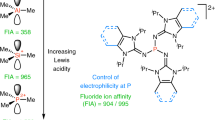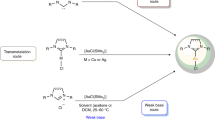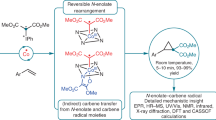Abstract
Carbyne anions (R–C–) are one of the least explored and most poorly understood subvalent carbon species and, so far, have only been observed in the gas phase. In this study, we report the synthesis and isolation of copper phosphinocarbyne anion complexes. The combination of a π-donor substituent and an electropositive transition metal enables the isolation of copper carbyne anion complexes at room temperature. The electronic structure of the isolated copper phosphinocarbyne anion complexes was probed using density functional theory calculations. These calculations reveal the dominance of ionic interactions between the copper and carbon atoms and the singlet ground state of the phosphinocarbyne anion, featuring a planar phosphorus atom and a short phosphorus–carbon bond. These complexes exhibit the reactivity of a carbyne anion, as demonstrated through the synthetic transformations to form silyl- and germanyl-substituted carbenes, diazaphospholidinyl-substituted alkenes and ethenimines.

This is a preview of subscription content, access via your institution
Access options
Subscribe to this journal
Receive 12 digital issues and online access to articles
$119.00 per year
only $9.92 per issue
Buy this article
- Purchase on Springer Link
- Instant access to full article PDF
Prices may be subject to local taxes which are calculated during checkout







Similar content being viewed by others
Data availability
General information, experimental procedures, 1H NMR/13C{1H} NMR/31P NMR/19F NMR spectra, X-ray crystallographic data, high resolution mass spectrometry data and infrared spectrometry data are provided in the Supplementary Information. For NMR spectra, see Supplementary Figs. 1–35. For selected NLMOs of HC≡C-CuIPent, P≡C-CuIPent, [H2C=C-CuIPent]+ and 6, see Supplementary Figs. 40–43. For crystallographic analysis, see Supplementary Fig. 36 and Supplementary Tables 2–11. For natural bond orbital analysis of 6 and C, see Supplementary Table 13. For the mechanism leading to 11, see Supplementary Table 14. Crystallographic data for the structures reported in this article have been deposited at the Cambridge Crystallographic Data Centre, under deposition numbers CCDC 2169399 (2), 2169400 (3), 2169401 (4), 2169402 (5), 2169403 (6), 2169404 (7), 2169405 (8), 2210613 (9), 2169406 (11) and 2210612 (12). Copies of the data can be obtained free of charge via https://www.ccdc.cam.ac.uk/structures/.
References
Moss, R. A., Platz, M. S. and Jones, M. Jr. Reactive Intermediate Chemistry (John Wiley & Sons, 2004).
Bates, R. B. and Ogle, C. A. Carbanion Chemistry (De Gruyter, 2022).
Wietelmann, U. & Klett, J. 200 years of lithium and 100 years of organolithium chemistry. Z. Anorg. Allg. Chem. 644, 194–204 (2018).
Yoshikai, N. & Nakamura, E. Mechanisms of nucleophilic organocopper(I) reactions. Chem. Rev. 112, 2339–2372 (2012).
Seyferth, D. The grignard reagents. Organometallics 28, 1598–1605 (2009).
Hinsberg, W. D. & Dervan, P. B. Synthesis and direct spectroscopic observation of a 1,1-dialkyldiazene. Infrared and electronic spectrum of N-(2,2,6,6-tetramethylpiperidyl)nitrene. J. Am. Chem. Soc. 100, 1608–1610 (1978).
Dielmann, F. et al. A crystalline singlet phosphinonitrene: a nitrogen atom–transfer agent. Science 337, 1526–1528 (2012).
Wentrup, C. Carbenes and nitrenes: recent developments in fundamental chemistry. Angew. Chem. Int. Ed. 57, 11508–11521 (2018).
Sun, J. et al. A platinum(ii) metallonitrene with a triplet ground state. Nat. Chem. 12, 1054–1059 (2020).
Mathey, F. Developing the chemistry of monovalent phosphorus. Dalton Trans. 36, 1861–1868 (2007).
Aktaş, H., Slootweg, J. C. & Lammertsma, K. Nucleophilic phosphinidene complexes: access and applicability. Angew. Chem. Int. Ed. 49, 2102–2113 (2010).
Liu, L., Ruiz, D. A., Munz, D. & Bertrand, G. A singlet phosphinidene stable at room temperature. Chem 1, 147–153 (2016).
Wang, Z., Herraiz, A. G., del Hoyo, A. M. & Suero, M. G. Generating carbyne equivalents with photoredox catalysis. Nature 554, 86–91 (2018).
Soleilhavoup, M. & Bertrand, G. Stable carbenes, nitrenes, phosphinidenes, and borylenes: past and future. Chem 6, 1275–1282 (2020).
Seburg, R. A., Hill, B. T., Jesinger, R. A. & Squires, R. R. The phenylcarbyne anion. J. Am. Chem. Soc. 121, 6310–6311 (1999).
Feng, E. et al. Gas-phase reactivity of phenylcarbyne anions. J. Am. Chem. Soc. 144, 8576–8590 (2022).
Liu, W., Guo, Y., Han, C. & Huang, X. Characteristic fragmentation behavior of 5-[1-aryl-1H-pyrrol-2-yl]-1H-tetrazole by electrospray ionization tandem mass spectrometry. Life Sci. J. 5, 25–29 (2008).
Fischer, E. O. et al. trans-halogeno[alkyl(aryl)carbyne]tetracarbonyl complexes of chromium, molybdenum, and tungsten —a new class of compounds having a transition metal-carbon triple bond. Angew. Chem. Int. Ed. Engl. 12, 564–565 (1973).
Guggenberger, L. J. & Schrock, R. R. Tantalum carbyne complex. J. Am. Chem. Soc. 97, 2935–2935 (1975).
Schrock, R. R. High oxidation state multiple metal−carbon bonds. Chem. Rev. 102, 145–180 (2002).
Jia, G. Recent progress in the chemistry of osmium carbyne and metallabenzyne complexes. Coord. Chem. Rev. 251, 2167–2187 (2007).
Zhu, C. & Xia, H. Carbolong chemistry: a story of carbon chain ligands and transition metals. Acc. Chem. Res. 51, 1691–1700 (2018).
Frogley, B. J., Hill, A. F. & Watson, L. J. Advances in transition metal seleno- and tellurocarbonyl chemistry. Chem. Eur. J. 26, 12706–12716 (2020).
Luecke, H. F. & Bergman, R. G. Synthesis, structural characterization, and chemistry of a monomeric cationic iridium carbyne complex. J. Am. Chem. Soc. 120, 11008–11009 (1998).
Carlson, R. G. et al. The metathesis-facilitated synthesis of terminal ruthenium carbide complexes: a unique carbon atom transfer reaction. J. Am. Chem. Soc. 124, 1580–1581 (2002).
Peters, J. C., Odom, A. L. & Cummins, C. C. A terminal molybdenum carbide prepared by methylidyne deprotonation. Chem. Commun. 32, 1995–1996 (1997).
Wengrovius, J. H., Sancho, J. & Schrock, R. R. Metathesis of acetylenes by tungsten(VI)-alkylidyne complexes. J. Am. Chem. Soc. 103, 3932–3934 (1981).
Giannini, L. et al. Genesis, redox, and acid−base relationships among WC, WC, and W⋮C functionalities over an oxo surface modeled by calix[4]arene. J. Am. Chem. Soc. 121, 2784–2796 (1999).
Lackner, A. D. & Fürstner, A. The triple-bond metathesis of aryldiazonium salts: a prospect for dinitrogen cleavage. Angew. Chem. Int. Ed. 54, 12814–12818 (2015).
Simpson, C. K. et al. Effects of cation–anion interactions on the structures and photophysical properties of anionic d0 tungsten–benzylidyne complexes. Inorg. Chim. Acta 345, 309–319 (2003).
VenkatRamani, S. et al. New alkylidyne complexes featuring a flexible trianionic ONO3– pincer-type ligand: inorganic enamine effect versus sterics in electrophilic additions. Organometallics 34, 2841–2848 (2015).
Brew, S. A., Gordon, F. and Stone, A. in Advances in Organometallic Chemistry Vol. 35 (eds Stone, F. G. A. & West, R.) 135–186 (Academic Press, 1993).
Hill, A. F. & Kong, R. Y. An anionic nucleophilic d4 carbyne complex. Chem. Commun. 53, 2032–2035 (2017).
Kim, S. J., Hamilton, T. P. & Schaefer, H. F. Phenylnitrene: energetics, vibrational frequencies, and molecular structures. J. Am. Chem. Soc. 114, 5349–5355 (1992).
Hrovat, D. A., Waali, E. E. & Borden, W. T. Ab initio calculations of the singlet-triplet energy difference in phenylnitrene. J. Am. Chem. Soc. 114, 8698–8699 (1992).
Hamilton, T. P., Willis, A. G. & Williams, S. D. Ab initio predictions of the lowest electronic states, structures vibrational frequencies of phenylphosphinidene. Chem. Phys. Lett. 246, 59–65 (1995).
Nguyen, M. T., Van Keer, A., Eriksson, L. A. & Vanquickenborne, L. G. Some calculated properties of phenylphosphinidene (C6H5P). Chem. Phys. Lett. 254, 307–313 (1996).
Hu, C. et al. Crystalline monometal-substituted free carbenes. Chem 8, 2278–2289 (2022).
Vignolle, J., Cattoën, X. & Bourissou, D. Stable noncyclic singlet carbenes. Chem. Rev. 109, 3333–3384 (2009).
Bourissou, D., Guerret, O., Gabbaï, F. P. & Bertrand, G. Stable carbenes. Chem. Rev. 100, 39–92 (2000).
Iluc, V. M., Laskowski, C. A. & Hillhouse, G. L. Synthesis of bis(phosphine) and N-heterocyclic carbene supported α- diazoalkyl complexes of copper(I). Organometallics 28, 6135–6138 (2009).
Pyykkö, P. & Atsumi, M. Molecular single-bond covalent radii for elements 1–118. Chem. Eur. J. 15, 186–197 (2009).
Igau, A., Grutzmacher, H., Baceiredo, A. & Bertrand, G. Analogous .alpha.,.alpha.’-bis-carbenoid, triply bonded species: synthesis of a stable .lambda.3-phosphino carbene-.lambda.5-phosphaacetylene. J. Am. Chem. Soc. 110, 6463–6466 (1988).
Kato, T., Gornitzka, H., Baceiredo, A., Savin, A. & Bertrand, G. On the electronic structure of (phosphino)(silyl)carbenes: single-crystal X-ray diffraction and ELF analyses. J. Am. Chem. Soc. 122, 998–999 (2000).
Colebatch, A. L., Frogley, B. J. & Hill, A. F. Phosphaisonitrile umpolung – synthesis and reactivity of chloro aminophosphino carbynes. Dalton Trans. 48, 10628–10641 (2019).
Wilson, D. W. N., Urwin, S. J., Yang, E. S. & Goicoechea, J. M. A cyaphide transfer reagent. J. Am. Chem. Soc. 143, 10367–10373 (2021).
Ziegler, T. & Rauk, A. On the calculation of bonding energies by the Hartree Fock Slater method. Theor. Chim. Acta 46, 1–10 (1977).
Mitoraj, M. & Michalak, A. Donor–acceptor properties of ligands from the natural orbitals for chemical valence. Organometallics 26, 6576–6580 (2007).
Mitoraj, M. & Michalak, A. Applications of natural orbitals for chemical valence in a description of bonding in conjugated molecules. J. Mol. Model. 14, 681–687 (2008).
Bader, R. F. W. A quantum theory of molecular structure and its applications. Chem. Rev. 91, 893–928 (1991).
Savin, A., Nesper, R., Wengert, S. & Fässler, T. F. ELF: the electron localization function. Angew. Chem. Int. Ed. Engl. 36, 1808–1832 (1997).
Zhao, L., Pan, S., Holzmann, N., Schwerdtfeger, P. & Frenking, G. Chemical bonding and bonding models of main-group compounds. Chem. Rev. 119, 8781–8845 (2019).
Lupinetti, A. J., Jonas, V., Thiel, W., Strauss, S. H. & Frenking, G. Trends in molecular geometries and bond strengths of the Homoleptic d10 metal carbonyl cations [M(CO)n]x+ (Mx+=Cu+, Ag+, Au+, Zn2+, Cd2+, Hg2+; n=1–6): a theoretical study. Chem. Eur. J. 5, 2573–2583 (1999).
Frenking, G. & Fröhlich, N. The nature of the bonding in transition-metal compounds. Chem. Rev. 100, 717–774 (2000).
Wang, X.-B. et al. Evidence of significant covalent bonding in Au(CN)2−. J. Am. Chem. Soc. 131, 16368–16370 (2009).
Emig, N., Tejeda, J., Réau, R. & Bertrand, G. The surprising instability of (phosphino)(stannyl)carbenes! Tetrahedron Lett. 36, 4231–4234 (1995).
Evanseck, J. D. & Houk, K. N. Theoretical predictions of activation energies for 1,2-hydrogen shifts in singlet carbenes. J. Phys. Chem. 94, 5518–5523 (1990).
Despagnet, E. et al. Stable non-push–pull phosphanylcarbenes: NMR spectroscopic characterization of a methylcarbene. Angew. Chem. Int. Ed. 41, 2835–2837 (2002).
Nakano, R., Jazzar, R. & Bertrand, G. A crystalline monosubstituted carbene. Nat. Chem. 10, 1196–1200 (2018).
Amsallem, D. et al. A rare example of a rearrangement involving four structural isomers: α-phosphinonitrile/c-phosphinoketenimine/1-aza-4-phosphabutadiene/1,2-dihydro-1,2-azaphosphete. Chem. Eur. J. 8, 5305–5311 (2002).
Valyaev, D. A., Filippov, O. A., Lugan, N., Lavigne, G. & Ustynyuk, N. A. Umpolung of methylenephosphonium ions in their manganese half-sandwich complexes and application to the synthesis of chiral phosphorus-containing ligand scaffolds. Angew. Chem. Int. Ed. 54, 6315–6319 (2015).
Valyaev, D. A. et al. A direct, modular, and efficient construction of the P-C-P structural motif through coupling of manganese carbyne complexes with phosphines. Chem. Eur. J. 20, 2175–2178 (2014).
Acknowledgements
We acknowledge financial support from the National Natural Science Foundation of China (grant nos. 22271132 and 22101114), Shenzhen Science and Technology Innovation Programme (grant no. JCYJ20220530114806015), Guangdong Innovative & Entrepreneurial Research Team Programme (grant no. 2021ZT09C278), Guangdong Basic and Applied Basic Research Foundation (grant no. 2022A1515011717) and Guangdong Provincial Key Laboratory of Catalysis (grant no. 2020B121201002). The theoretical work was supported by the Center for Computational Science and Engineering and the CHEM High-Performance Supercomputer Cluster at SUSTech. We acknowledge the assistance of SUSTech Core Research Facilities. We thank D. A. Ruiz at SUSTech for polishing this paper.
Author information
Authors and Affiliations
Contributions
L.L.L. conceptualized and supervised the project. R.W. and X.F.W. performed the experimental work. L.L.L., R.W. and C.H performed the computational work. R.W. performed the X-ray crystallographic analyses. L.L.L. wrote the paper with the input from all authors. All authors discussed the results in detail and commented on the paper.
Corresponding author
Ethics declarations
Competing interests
The authors declare no competing interests.
Peer review
Peer review information
Nature Synthesis thanks Didier Bourissou and the other, anonymous, reviewer(s) for their contribution to the peer review of this work. Primary Handling Editor: Thomas West, in collaboration with the Nature Synthesis team.
Additional information
Publisher’s note Springer Nature remains neutral with regard to jurisdictional claims in published maps and institutional affiliations.
Supplementary information
Supplementary information
General information, experimental section, Supplementary Figs.1–43, Tables 1–14, computational details and references.
Supplementary Data 1
Crystallographic data for compound 2, CCDC: 2169399.
Supplementary Data 2
Crystallographic data for compound 3, CCDC: 2169400.
Supplementary Data 3
Crystallographic data for compound 4, CCDC: 2169401.
Supplementary Data 4
Crystallographic data for compound 5, CCDC: 2169402.
Supplementary Data 5
Crystallographic data for compound 6, CCDC: 2169403.
Supplementary Data 6
Crystallographic data for compound 7, CCDC: 2169404.
Supplementary Data 7
Crystallographic data for compound 8, CCDC: 2169405.
Supplementary Data 8
Crystallographic data for compound 9, CCDC: 2210613.
Supplementary Data 9
Crystallographic data for compound 11, CCDC: 2169406.
Supplementary Data 10
Crystallographic data for compound 12, CCDC: 2210612.
Supplementary Data 11
Cartesian coordinations of the optimized structures by DFT calculations.
Rights and permissions
Springer Nature or its licensor (e.g. a society or other partner) holds exclusive rights to this article under a publishing agreement with the author(s) or other rightsholder(s); author self-archiving of the accepted manuscript version of this article is solely governed by the terms of such publishing agreement and applicable law.
About this article
Cite this article
Wei, R., Wang, XF., Hu, C. et al. Synthesis and reactivity of copper carbyne anion complexes. Nat. Synth 2, 357–363 (2023). https://doi.org/10.1038/s44160-022-00225-y
Received:
Accepted:
Published:
Issue Date:
DOI: https://doi.org/10.1038/s44160-022-00225-y
This article is cited by
-
Carbyne anions get to work
Nature Synthesis (2023)



